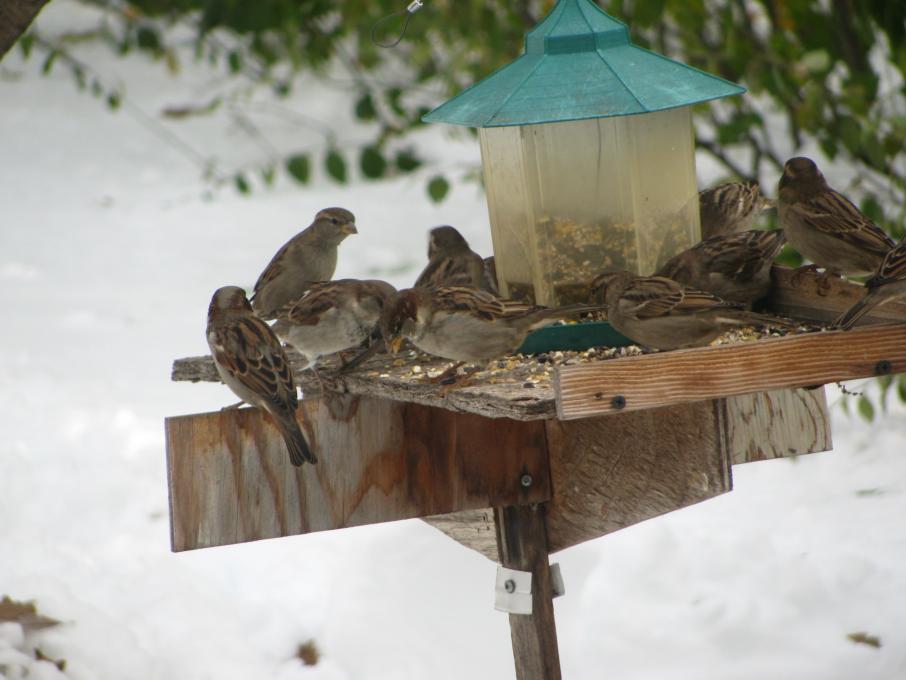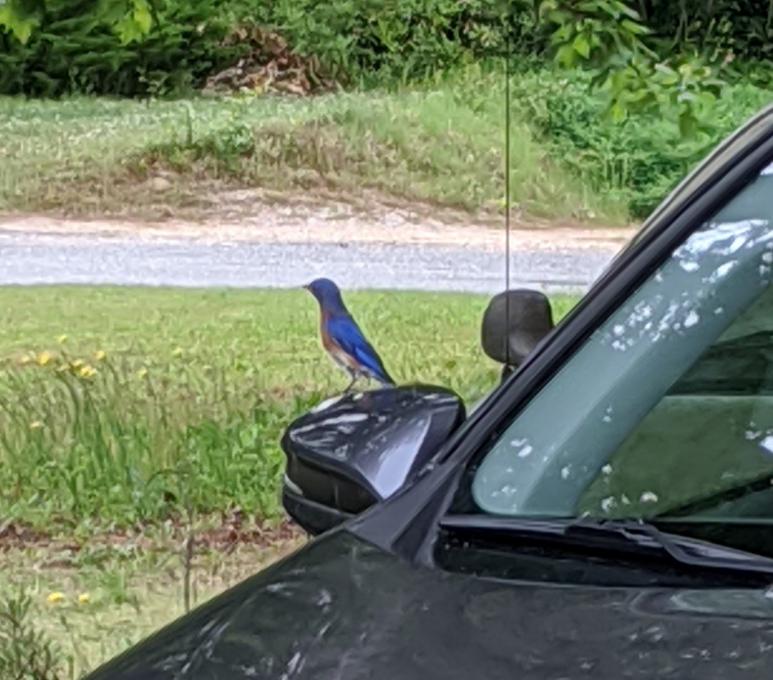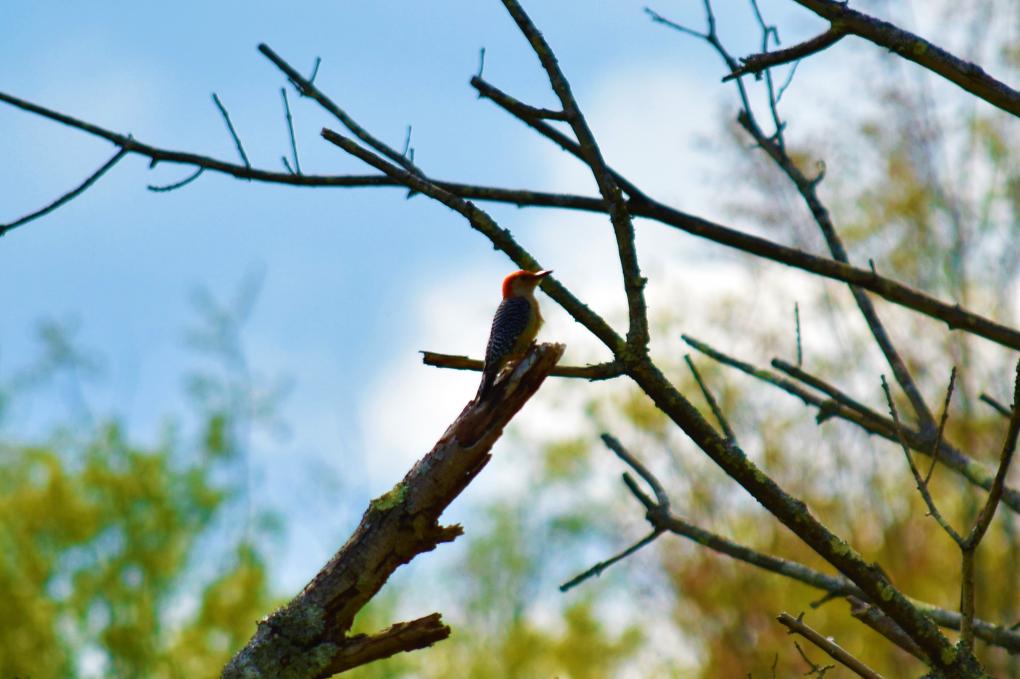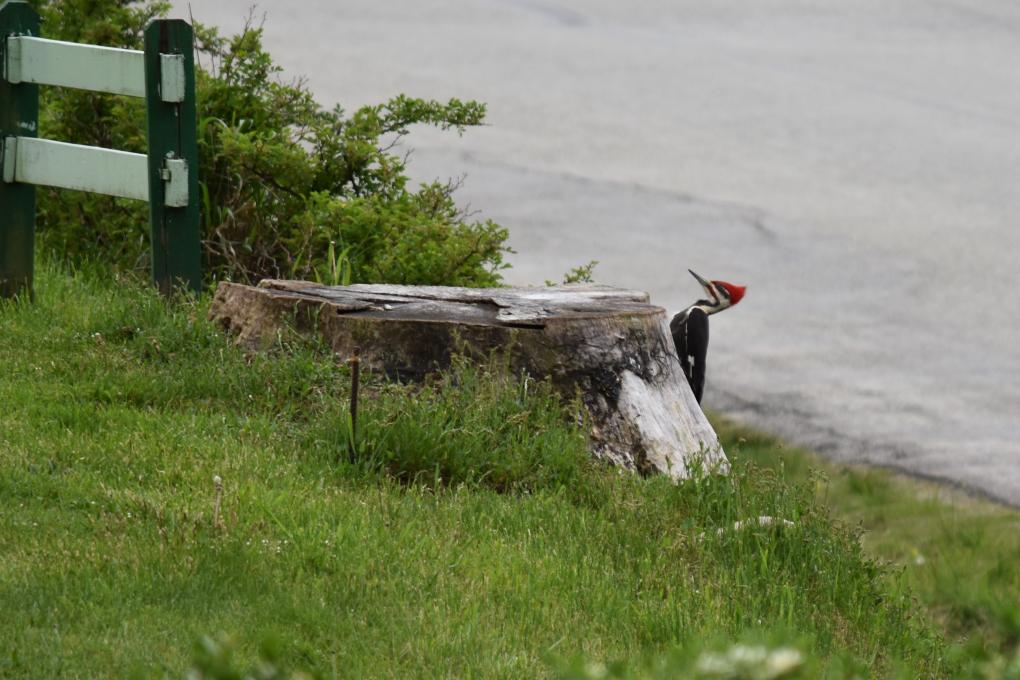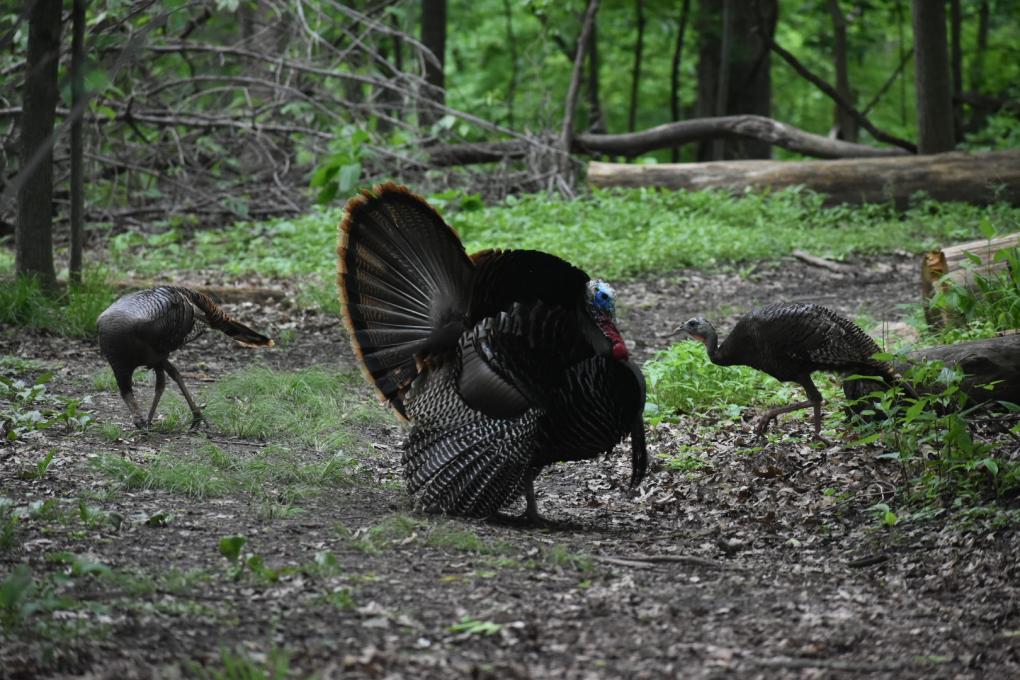The Cornell Lab Bird Academy › Discussion Groups › Joy of Birdwatching › Activities: Bird ID Practice
-
Activity #1 I looked at the Pileated Woodpecker cam. Saw both male and female feeding. Never saw them that closely before but now I see the red on the male's cheek clearly. Also saw what I think is probably a male Brewer's Blackbird flitting in and out. Pale yellow eye, iridescent plumage and rounded tail often diamond shaped. I've only seen them in winter plumage before with less iridescence. Flocks of them used to land on my lawn in Powell River, BC, Canada mixed in with Red-winged and a lot of Starlings. They came around Christmas Bird count time so we used to go looking for them to add to our count. This year, I've seen lots of Starling flocks but very few Brewers with them and no Red-wings. I wonder if both the Red-winged and Brewers numbers are down and why?
-
Activity#1 - in our backyard I saw a robin and a hummingbird - easy to tell apart. activity #2 - I saw 3 black birds outside - a grackle, a starling and a cowbird. Grackle has an iridescent hood, cowbird has a brown hood and the starling has speckles of yellow throughout its body.
 activity # 3 - mourning doves search on the ground for food; hummingbirds feed at the nectar feeder; yellow finch feeds at seed feeder.
Activity #4 - the goldfinch is a small bird, about the size of a sparrow. The male is bright yellow with black markings on its wings. When flying it dips and swoops, intermittently flapping its wings.
phew! I think I covered all the activities!
activity # 3 - mourning doves search on the ground for food; hummingbirds feed at the nectar feeder; yellow finch feeds at seed feeder.
Activity #4 - the goldfinch is a small bird, about the size of a sparrow. The male is bright yellow with black markings on its wings. When flying it dips and swoops, intermittently flapping its wings.
phew! I think I covered all the activities!
-
I am enjoying these activities, as they have helped me think about identification strategies I'm not prone to using. For reference, I'm located in the suburbs of Philadelphia, near a river and small wooded areas, so most of my sightings and activities have been regarding birds typical of this area. Activity 1: Two birds I can easily tell apart by shape are blue jays and mourning doves. Activity 2: Three birds that share the same color on different parts of their bodies are cardinals, red-wing blackbirds, and red-bellied woodpeckers. Activity 3: Behaviors of 3 birds searching for food: white-breasted nuthatch climbing down a tree, robins grazing on the ground, and eastern peewee flying out and back from a branch. Activity 4: I saw a cedar waxwing this weekend and here's how I identified it: First, I noticed it was perched high in a treetop in a grove of old-growth trees (behavior, habitat), its yellow belly visible from below. I initially considered it may be a type of warbler, but it was roughly the size of a robin (size), and in particular the yellow tip of the tail gave it away (markings). The crest and black mask only served to confirm my ID. Later that day, I recognized the high-pitched whine (sound) while outside my house and saw that three cedar waxwings decided to visit a large oak in my yard!
-
Activities 1-3: During a walk last week, I noted around 4 grey-colored birds. 2 of them were mourning doves - which seem to be quite prevalent this Spring. I already knew the shape/appearance of the morning dove. But the other birds were very beautiful and I hadn't really noticed this type before (at least not close up). Using the Merlin app, I discovered they were cat birds. This was quite a surprise. I didn't realize they were so beautiful. Regarding food foraging, on the same walk (if I recall correctly) I saw some robins in their typical worm retrieving behavior. And I noticed quite a few house sparrows flittering in the grass and others just hanging out. There were a mix of males and females - and although sparrows are quite common by my complex, the black bibs on these really stood out. I went back to my field guide and identified them as house sparrows - which made me feel good because sparrow identification is definitely not my strong point (yet). I realized I have much to learn about sparrow identification. Recently, I was awoken by a very loud drumming of a woodpecker. Although I did not see the bird, I imagined that perhaps this was the same pileated woodpecker who visited a month or so ago, just based on the loudness of the drilling. But that is probably not alot to go on, as drilling even from a smaller one can be louder than expected. We get alot of them in the trees by my apartment.
-
Apparently the system does not like the association of "e-r-e-c-t" and "stance" together that were used to describe the fact that the nuthatch does not have the same posture as other perching birds.
-
attempt #4 - the remainder of activity 2 which is now split into three responses; Activity 2 – White-breasted Nuthatch: “dark crown and nape; white face; gray back” [ca. 6”], narrow pointed beak, creeps down tree trunks, eats at feeders, tends to occur as one or two individuals, correct range.
-
Third attempt to get it all in: Activity 2 – three black and white birds: Chickadee: “black cap and bib; white cheeks, buff flanks” [ca. 5 ¼ “], foraging in trees or at feeders, “winter flock of 6-10 birds”, distinctive song, correct range.
-
this is part two - actually the first part of my response as I am trying to determine why the system gave me an error that I was using mature or inappropriate language? Activity 1 – distinguishing by size/shape/attitude/activity – From sightings on the Souris River at Wawanesa, Manitoba: Bufflehead & Double-crested Cormorant. Using Stokes Field Guide: Bufflehead, “small duck [ca. 14”] with a large rounded head.” Swimming in river, short neck, large white “wedge at back of dark head” range includes S. Manitoba; Cormorant, larger bird [ca. 33”] stands semi-upright on log or swims with body low in water, all black, long neck, long orange beak, range includes S. Manitoba.
-
Dark-eyed Junco: (slate coloured race), “pale bill; dark eye; whitish belly; tail dark with conspicuous white outer feathers”, [ca. 6”] , dark gray with white belly, small short heavier beak, correct range. Activity 3 – food finding behaviour: Robin – walking on ground listening probing ground; Chipping Sparrow – rapid movements along ground or in trees; House Sparrow – searching grass and leaf litter for food. Activity 4 – identify favourite bird: Raven – black, wedge shaped or rounded tail, moderate to large size, correct range, wide range of vocal croaks, squawks, mews and gargles, [you can tell when a hawk is around as there is a very rapid “Hawk, Hawk, Hawk”] spends time training up young with many lessons and determined weaning, loves to soar and play in the wind. Re: photo - We have had over 120 house sparrows at our feeder, porch and yard at one time under certain winter weather conditions. Particularly ca. -30 C., sunny, and north or northwest wind.

-
That is so lovely, Stephen!!! I'm jealous--since I join some others with the squirrel frustration. Here there are greys (majority), some with a reddish top on its back and tail, some blacks, and.... some whites. Others have said that even the so-called "squirrel-proof" bird-feeders are no match for this army. Do you not have that problem? Many of the classmates do a lot of bird-watching and identifying from their house, through their feeder: I would love to do that, too..... :(
-
-
It's disappointing that these discussion threads are not moderated. Everyone posts a comment, but then there are very few to almost no responses and no responses from a moderator. This makes the discussion threads not very useful for learning -- there is no "discussion" that occurs.
-
# 1. My larger garden and bird feeders are on the east side of my house. Looking east in the early morning or a bright overcast day it's often hard to see colors so I am forced to pay careful attention to silhouettes which is a real challenge with finches except for the Pine Sisken which is the smallest and often likes to feed upside down. The Northern flicker and Downy woodpecker are easy because they are the largest and smallest of the woodpeckers. (The Pileated is larger but has a shape all its own.) I've learned to recognize the Downy by the size of its bill in relationship to the diameter of the head, almost more easily done when it's a silhouette. #4. One of my favorite birds is the Chickadee of which I have two types: Black capped and Chesnut backed. Both have black caps and chin patches under their beaks. A white V area spreads from the beak to the back of the cheek, only I've notieced that a few have a curved line on the top side of the "V". By reading up on them for this assignment I learned that that is an Eastern trait as is buffy yellowish undersides as opposed to the brownish undersides of the western Black caps so our area in the Pacific Northwest has a mixture of Blackcaps. The Chesnut backed look like they're wearing a rust colored vest. Both tend to flit and fly fairly rapidly from branch to feeder and back around the branches (not on the ground). They only take one seed at a time and then peck at it daintily on their perch.
-
Regarding your woodpecker comment, Carolyn, I found the exercise in this lesson *very* useful: identify the woodpecker, in ten tries. It helped me "identify" the marks I needed to look at in order to identify the bird. That was the visual part--I'm going to have to go through the sound part again, am finding that more difficult for some reason: love to hear them all the time, but I guess I hear it as a concert--now I'l have to work on the solos...
-
-
Today I took a walk and brought my binoculars, which I have recently learned how to use thanks to this course! I live on a country road in rural Massachusetts, with both wooded and meadow areas. Lots of birds and bird songs today! The first thing that happened was I heard a song that was unfamiliar to me. I stood still and looked for the bird, and then kept my eyes on it as I brought the binoculars up. But I didn't really need to look through them to know it was a Baltimore Oriole! Beautiful. It stayed with me as I walked, and kept singing that same song of an upward note and then a downward note. I started trying to copy it, and it seemed to be answering me! I also saw what I knew was a woodpecker from the coloring of black with bright red, and also because it was walking up the trunk of a tree. I was assuming it was either a downy or hairy woodpecker, and was focusing on the beak to see if I could figure out which one, and had settled on hairy. But the thing was that it seemed too big. I knew it wasn't big enough to be a pileated, but it had a red crown like the pileated. I checked Merlin, which suggested Yellow-Bellied Sapsucker. Ooo maybe! Reading about it in my book, I think that's what I saw. I learned about a new bird today. I also think that might be the drumming we hear in the evening, because the book says they are territorial and drum loudly. I also saw an Indigo Bunting today! I have caught sight of some beautiful blue birds flying in front of my car on occasion, and today I saw one through my binoculars, and got a much better look at it. I'm much more sure that it is an Indigo Bunting that I have been seeing.
-
Dear Bird Academy, I am writing to comment on the activities I have participated so far.I thought that participating in these lessons were really helpful!it helped me a lot and I got to capture the beautiful birds in the trees around me. I would like to thank you as well. I was actually loved birds since I was young and I longed to get the opportunity to watch a bird in the wild flying in the wild up close. I only knew that using binoculars to watch birds was the only way to have a closer look at it after participating in your course. I also felt that attending your lessons and activities improved my bird-watching skills. After reading the bird academy provided notes, I thought that the notes were dam helpful! I really want to thank the bird academy staff for all the efforts they have put in to help me in bird watching. I look forward to seeing your reply. Yours Faithfully, Jerry Lee ( a participant of bird academy)😀
-
Activity #4. My favorite bird today is the Eastern Bluebird because I could ID it! I used color-- predominantly blue body, red breast, some white-- and size (robin-sized) mostly, plus being here in Virginia. The bird was alone, not social, and flitted between a tree and our car. I also used the Merlin app to confirm, which it did. I like the process of checking multiple sources while I am still at this early stage of learning.

-
Hi Barbara, I am Jerry (chirps 1), which country do you live in? I think that picture of an Eastern Bluebird is very beautiful! I have never seen that before. Well, I have a Rock Pigeon that visits us sometimes, I name it Do Do.
-
Very nice pic of the bluebird. It seems quite large, or is that just how it looks from the angle. I didn't realize they got that large!
-
-
Activity #1: So for this activity, I saw a Pileated Woodpecker and a Red-Bellied Woodpecker. One of first things I noticed was the size of the birds. The Pileated Woodpecker is much larger, about the size of a Crow. The Red-Bellied Woodpecker is more medium sized, about the size of a Blue Jay. The head of a Pileated Woodpecker has a red crown with very long beak. The Red-Bellied Woodpecker has a much rounded normal bird head with a shorter beak. The Red-Bellied Woodpecker has black and white stripes on its wings and back where as the Pileated is mostly black when its not in flight. Even though both of these birds are from the Woodpecker family. They are easily able to be identified from each other due to their many differences to each other. Please enjoy the pictures that I took of these two beautiful birds!


-
Awesome picture of the Pileated woodpecker!
-
-
we love the live bird cam at feeder, and used Merlin to ID grackles. We also knew the red-winged blackbird and a female cardinal. We plan on using the live bard cam in the future to get more experience identifying birds we aren't familiar with.
-
Hi everyone. For activity 4 I have chosen a male golden whistler. He is a small bird. Short body and medium length tail. Small beak which curves slightly downwards to a point. Mostly yellow, but with black head and nape, and olive green wings. It has a white throat or bib, and black chest band. Legs, beak, and eyes are black. Seen in Australian bushland perched on a horizontal gum tree branch, singing his distinctive and loud song.
-
1. This evening we walked to the reservoir and saw a pair of horned grebes, and a pair of buffleheads. They are both small duck-like water birds, but have very different shapes. The buffleheads looked rounded and compact, and the male has a large, bright white patch on the back of his head. The female has a little white patch on her cheek, and is mostly grey and black. The male and female grebes have the same coloring, with a long thin neck, longer narrow beak and a bright yellow/orange tuft from their eye to the back of their head. They look very striking, but they're not round and chunky looking as the buffleheads. 2. Red: The male sapsuckers have bright red on the top of their heads and on their throats. The male red winged blackbirds have a bright red patch on each shoulder/wing. The red breasted nuthatch has reddish orange on his chest. 3. Food finding: The northern harriers spends a lot of time flying, gliding low above the fields and trees, looking for something to eat. The white throated sparrows in my yard spend lots of time searching for food on the ground. They hop twice then peck into the grass, or into my flower beds. It just stopped raining today, and the robins are hopping through the wet grass looking for food. They don't seem to both with little insects; i think they are eating the worms that came up to the surface because of all the rain. 4. The northern harrier is a medium size raptor, smaller than a red tailed hawk, but way bigger than a kestrel. It has a white rump patch, and flies low to the ground, gliding with its wings held high in an elegant v shape, rather than holding them parallel with the ground. It frequents the farmland and small lakes, but is less commonly seen in the conifer forest areas. I listened to its recorded call on the Merlin app, but i have never heard them make a sound when they fly by...
-
activity 1: crows and ravens are common here in Santa Fe. Now, when I see one soaring I know it's a raven! If it's flapping away I assume it's a crow. The tail shape (rounded for crow and wedged for raven) is more difficult for me to discern. On the ground, the size difference, and the raven's shaggy throat makes identifying easier.
-
My feeders and larger garden are on the east side so in the morning I am looking into the rising sun. Early morning and overcast days it's bright and difficult to see colors so I am working on learning birds from their silhouettes - a challenge with the finches. The Downy woodpecker and Norther Flicker are easy because the Flicker is huge compared to the Downy and I've learned to gauge that in relationship to the suet feeder and seed cylinder. I used to have both Downey and Hairy woodpeckers in eastern Washington and finally learned to gauge the beak length in relation to the head. One of my favorite birds is the the chickadee: I have Blacked capped and Chesnut backed here. They are larger and rounder through the breast than the humming birds and smaller than sparrows and tend to dart about from branch to feeder and back to branch or bush. Both types have black caps on their heads and white cheeks that spread in a V from beak to back on their cheeks. The Chestnut backed look like they are wearing a rust colored vest and the Blacked capped are grey brown or buffy yellowish underneath. I had noticed that a few of mine had a cheek with a curve between white and black along the upper side of their head as opposed to a straight V line and I've learned that those are like the eastern version which also includes the yellowish undersides, so we have a mix of eastern and western types here now - a fact I learned doing this lesson.
-
This gobbler and hens are relatively common in some areas of St. Louis County Missouri. He works so hard to get the attention of the hens and they seem to simply ignore him.

-
Baltimore Oriole that we were able to enjoy for about 3 days until he left. South St. Louis, Mo.

-
I saw a Baltimore oriole and a wild turkey
-
Today in my yard I had to Morning Doves a male and a female, but I wasn't sure what they were looking for let me know if anyone has any ideas.
-
Activity 1: The Steller's Jay and California Scrub Jays which are so prevalent in our area, while (sort of) having similar colors, are easy to differentiate by shape due to the Steller's pompadour-like crown. Activity 2: The Varied Thrush, and Black-headed Grosbeak are easily confused for me due to the similar colors; and throw in the American Robin, especially when they all are moving, and things get messy:-) I find that the patterns (like the Varied Thrush's necklace) can really help distinguish birds with similar colors and size and shape. Activity 3: The Scrub Jay and Northern Flickers were both foraging on the ground in a nearby meadow today, but it seems the Flicker was looking for food, while the Jay may have been looking for nesting material. And the Acorn Woodpeckers seem to be ...well looking for acorns.:-) Activity 4: One of my favorites is the Acorn Woodpecker with [1] their clown-ish call (hee haw, hee haw), [2] their red cap, [3] their always seeming to move in groups and [4] the flash of white on their wings when they are in flight.
Read More:
 activity # 3 - mourning doves search on the ground for food; hummingbirds feed at the nectar feeder; yellow finch feeds at seed feeder.
Activity #4 - the goldfinch is a small bird, about the size of a sparrow. The male is bright yellow with black markings on its wings. When flying it dips and swoops, intermittently flapping its wings.
phew! I think I covered all the activities!
activity # 3 - mourning doves search on the ground for food; hummingbirds feed at the nectar feeder; yellow finch feeds at seed feeder.
Activity #4 - the goldfinch is a small bird, about the size of a sparrow. The male is bright yellow with black markings on its wings. When flying it dips and swoops, intermittently flapping its wings.
phew! I think I covered all the activities!
